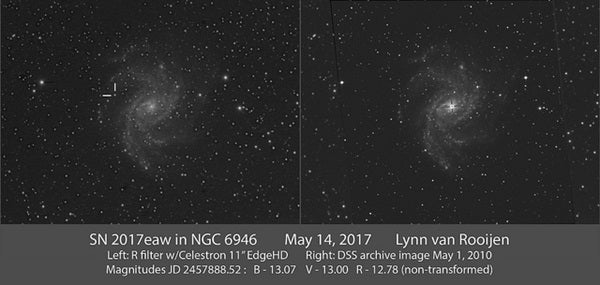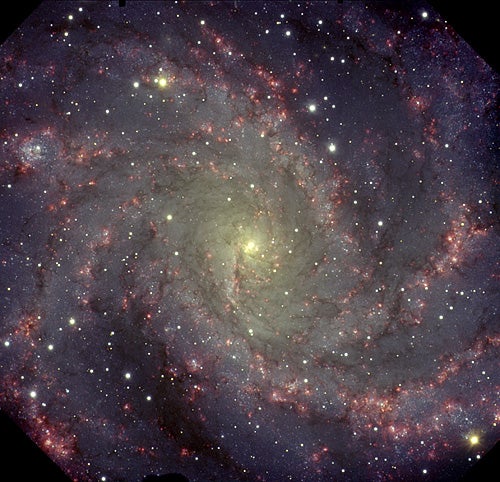A new supernova just lit up the sky, and it’s bright enough for amateur astronomers to search out with their scopes. Named SN 2017eaw, this event marks the death of a massive star and the 10th supernova observed in NGC 6946, otherwise known as the Fireworks Galaxy, in 100 years. If you have a 6-inch scope or larger and access to dark skies, you can find this supernova to the northwest of its host galaxy’s nucleus as it continues to brighten for up to a week, then remains bright for several more weeks.
The transient object was first announced as a potential supernova by amateur astronomer Patrick Wiggins on May 14, who identified it by comparing an image he’d taken that day with previous images of the galaxy both one year and two days prior. Neither of the previous images showed an object in the location where the new object had appeared. Wiggins imaged the galaxy through his 14-inch (0.35-meter) f/5.5 reflector from his location near Erda, Utah. The supernova was confirmed five hours later by the Virtual Telescope Project with the 16-inch (0.41m) f/3.75 Tenagra III robotic telescope (called Pearl) at Tenagra Observatories in Arizona. Amateur astronomers can find the supernova at R.A. 20h34m44.24s, Dec. +60°11’35.9”, close to the border separating Cygnus and Cepheus.
Spectroscopic observations of the supernova have identified it as a type II-P supernova, one the most common supernova events in the universe. Type II supernovae are core-collapse events, which occur when a massive star reaches the end of its life. Prior to the supernova, the core of the star has been shrinking, as fusion inside slows and reduces the pressure outwards from within the core. Eventually, the core shrinks to a critical point, causing a rebounding shockwave that propagates outward, destroying the outer regions of the star as a type II supernova. In this case, the “p” stands for “plateau,” because these supernovae have a brightness profile that grows and then plateaus, staying the same for months before the object fades.
This plateau in brightness is caused by the ionization (stripping of electrons) of the hydrogen in what was once the envelope of the progenitor star. As the shockwave from the supernova moves through the envelope, it heats the hydrogen there to temperatures over 100,000 Kelvin (180,000 degrees Fahrenheit [99,700 degrees Celsius]) Heating ionizes the hydrogen, which then becomes opaque, meaning it absorbs light coming from the inner regions of the supernova. Astronomers can only see radiation from the outermost layers of the star, which remains consistent, for several weeks, and is dominated by hydrogen emission when viewed through a spectrograph. Eventually, the hydrogen cools enough to regain its lost electrons, turning into neutral hydrogen that allows radiation from deeper within to escape.
Not all transient objects are supernovae; objects such as bright asteroids can sometimes wander through images, causing astronomers to think they’ve seen a supernova. To rule this out, Wiggins first watched the object for more than an hour to detect possible motion. Additionally, Italian astronomer Gianluca Masi, manager of the Virtual Telescope Project, performed a thorough check of the object’s position against all known asteroids in the vicinity. None, however, had orbits crossing the Fireworks Galaxy when the discovery was made.
The Fireworks Galaxy lies about 22 million light-years from Earth, and has now hosted 10 supernovae in its arms since the beginning of the 20th century. It is also classified as a starburst galaxy, meaning it is currently undergoing a period of intense and rapid star formation. This is why so many supernovae have been spotted — the more massive stars created in a short period of time, the more massive stars will also reach the end of their lives in a similarly short period of time.
If you don’t have access to dark skies, never fear — you can view the Fireworks Galaxy’s 10th supernova in 100 years on May 19 via an online observing session on the Virtual Telescope Project’s website.











